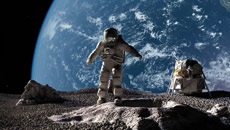Researchers said Thursday that they have identified a nearly complete skeleton in an underwater Mexican cave, a discovery that could help resolve a longstanding debate about the origins of the first people to inhabit the Americas.
The skeleton of a prehistoric teenage girl girl, whom the team calls Naia Naia ("water nymph" in Greek), was found in 2007 in a large pit known as Hoyo Negro in Mexico's eastern Yucatan Peninsula, which is now reachable only by divers, according to Xinhua.
The remains with an intact cranium and preserved DNA, were surrounded by at least 26 large animals, including saber-toothed cats, giant ground sloths and elephant-like gomphotheres, the team reported in the US journal Science.
The girl, about 15-16 years old, apparently fell into this cave and "died almost instantly" because her pelvis appears to have been broken at or around the time of her death, James Chatters of Applied Paleoscience in Bothell, Washington, who led the study, told reporters.
"It appears that she fell quite a distance and struck something hard enough to fracture her pelvis," Chatters said. "It's possible she was looking for water because the Yucatan was extremely dry" during the time she lived.
According to the researchers, Naia's resting place, now 42 metres under water, would have become submerged during sea level rise between 9,700 and 10,200 years ago as global glaciers melted, long after Naia and the other extinct animals likely fell into it.
Based on radiocarbon dating of tooth enamel and analyses of mineral deposits on the bones of the girl, the researchers placed her age between 13,000 and 12,000 years ago, making her one of the six oldest humans yet found in the Americas.
The girl possesses the unique skull and facial features of the earliest Americans, including "a much narrower, more projecting face, much wider set eyes, a more prominent forehead and nose," he said. These differ markedly from those of today's native Americans, who tend to have broader and rounder skulls.
To understand more about her ancestry and its potential linkage to modern native Americans, the researchers extracted DNA from her molars and the analysis showed that the girl belonged to a genetic lineage that is shared only by native Americans today.
The researchers said the finding showed that native Americans have descended from the earliest Paleoamericans, who moved onto the Bering Land Bridge, an area once above water between Siberia and North America, from northeast Asia between 26,000 and 18,000 years ago, spreading southward into North America sometime after 17,000 years ago.
"This study therefore provides no support for the hypothesis that Paleoamericans migrated from Southeast Asia, Australia or Europe," study co-author Deborah Bolnick, assistant professor of anthropology at the University of Texas, said.
The researchers said that the physical differences between Paleoamericans and native Americans today likely arose not from separate origins but from evolution that occurred in Beringia and the Americas over the last 9,000 years.





